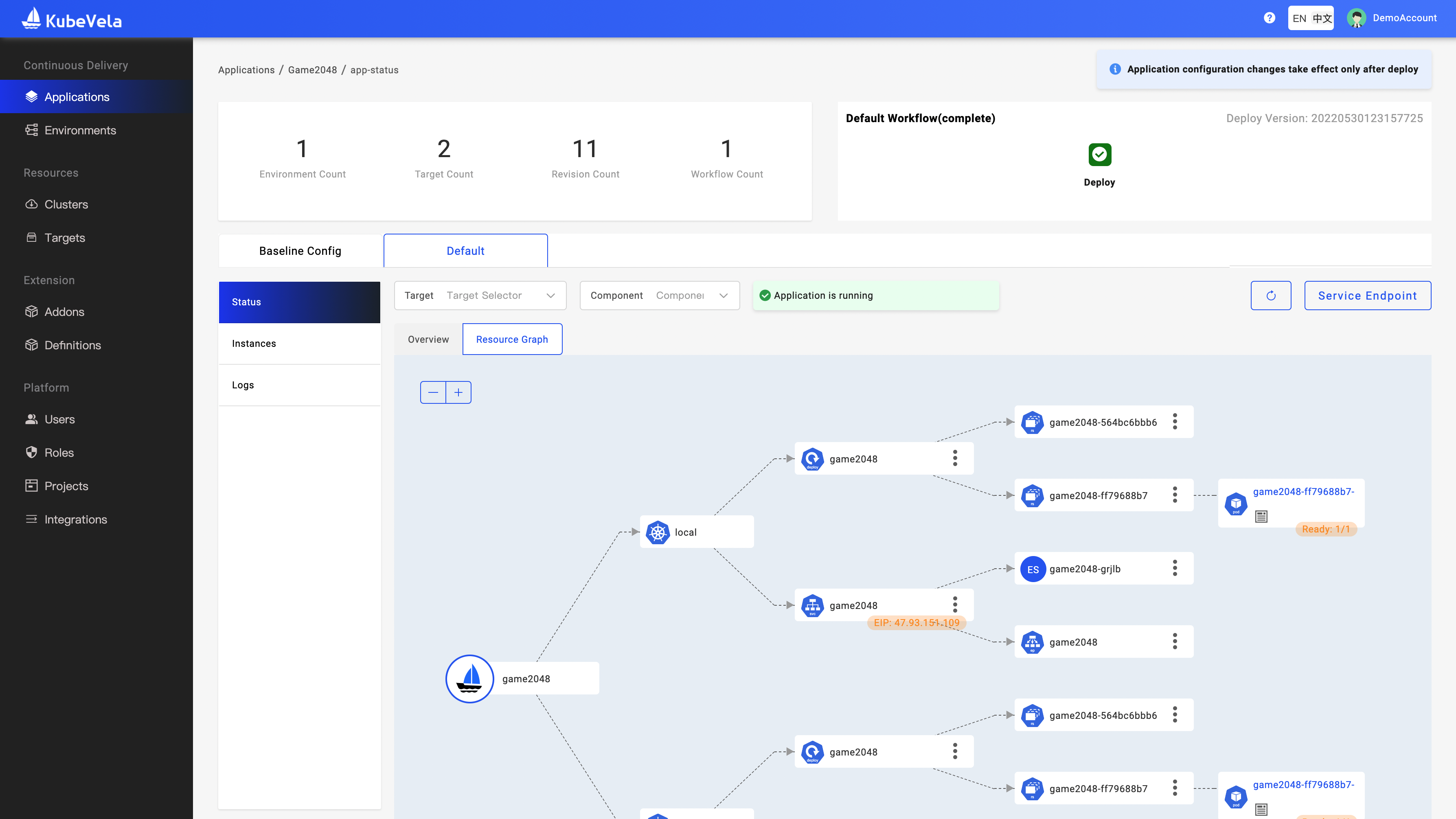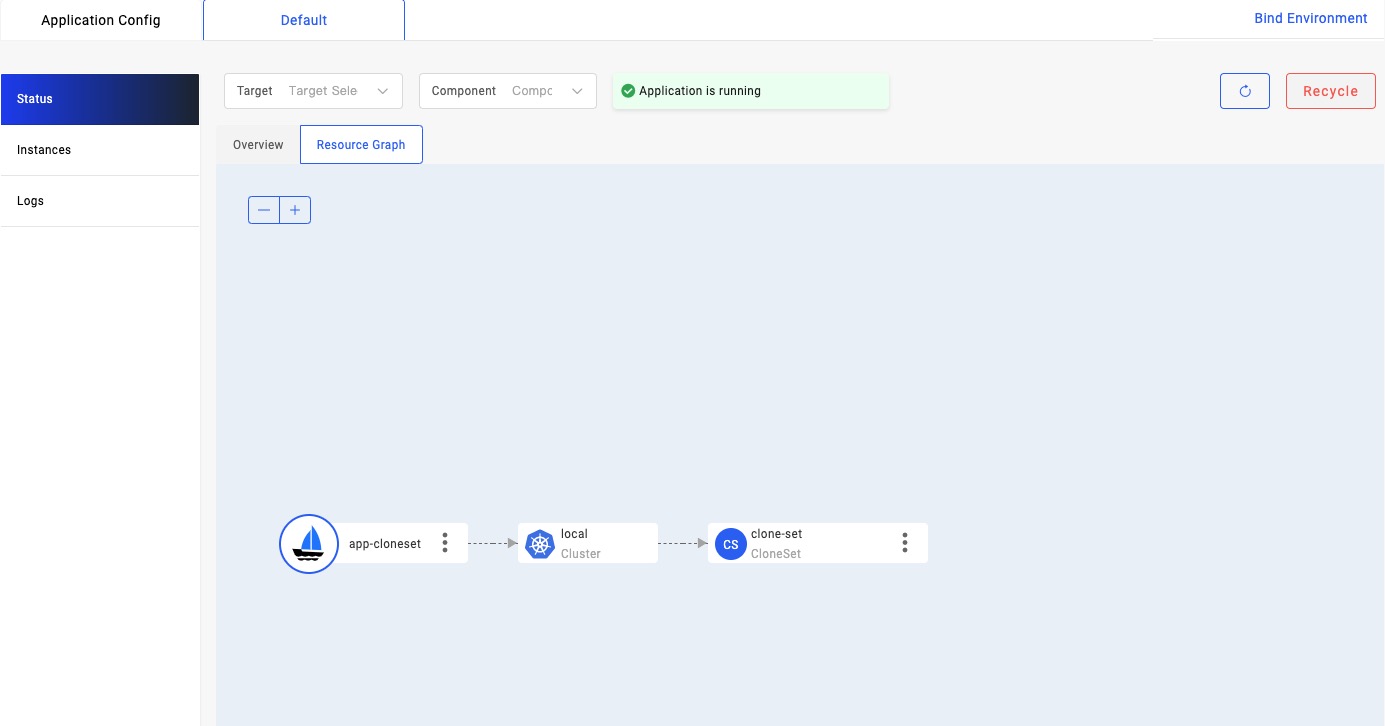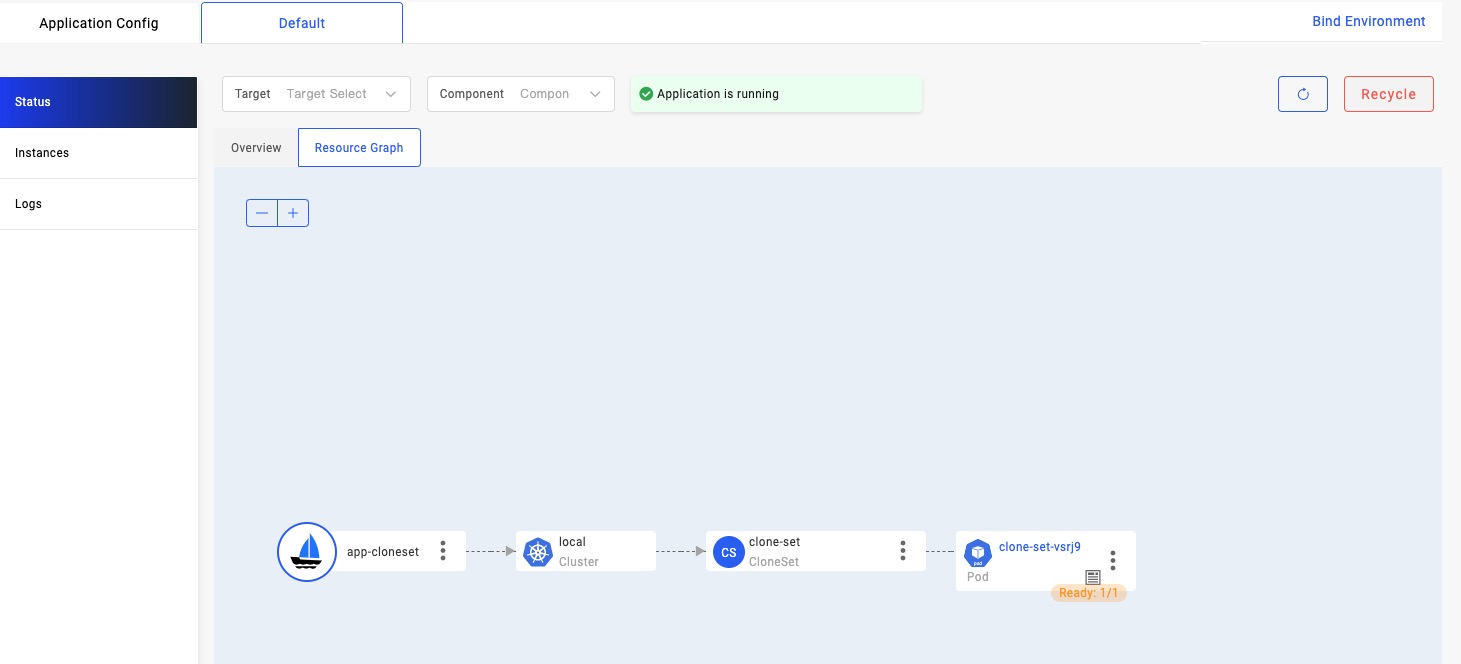Resource Relationships
Resource Relationships mainly specify the relationship between two types of resources. Its main function is to help KubeVela establish the topological relationship of the resources managed by a KubeVela application. For example, the system has a built-in relationship rule: The sub-resources under the Deployment can only be ReplicaSet , and the child resource of ReplicaSet can only be Pod.
When a KubeVela application with Deployment as the workload is created, then view the topology graph of the application on VelaUX, KubeVela will first list all ReplicaSets in the same namespace with the Deployment, and filter out the results whose OwnerReference don't point to the Deployment, and then find the Pod under the ReplicaSet with the same way. This can help to establish the topology hierarchy of the managed resources under the application.
In general, these Resource Relationships are mainly used in the following scenarios:
- Help to display the topology graph of an application on VelaUX. The following is an example of topology graph:

- When using
vela port-forward,vela logs,vela execandvela status --endpointvia cli or check the log or access port of an application on VelaUX, it helps KubeVela to discover the pods or services of an application.
Add more rules
The built-in Resource Relationships in the system are limited. If a Kubernetes CustomResourceDefinition is added to your cluster, you can add new relationship rules to the system by creating a Kubernetes configmap to your cluster.
Then we will introduce the details with an example.
You can first enable the kruise addon which is an experimental addon by running follow command:
vela addon registry add experimental --type=helm --endpoint=https://addons.kubevela.net/experimental/
vela addon enable kruise
After enable succeed you will see the cloneset componentDefinition whose workload's type is clonesets.apps.kruise.io. The cloneset controller will create pods for application.
$ vela componets
NAME DEFINITION DESCRIPTION
cloneset autodetects.core.oam.dev Describes long-running, scalable, containerized services
that have a stable network endpoint to receive external
network traffic from customers. If workload type is skipped
for any service defined in Appfile, it will be defaulted to
`webservice` type.
Then, create a cloneset application:
cat <<EOF | vela up -f -
apiVersion: core.oam.dev/v1beta1
kind: Application
metadata:
name: app-cloneset
spec:
components:
- name: clone-set
type: cloneset
properties:
cmd:
- ./podinfo
- stress-cpu=1
image: stefanprodan/podinfo:4.0.3
port: 8080
updateStrategyType: InPlaceOnly
EOF
When we view the application topology graph on VelaUX, we will find out the clonset resources has not any sub-resource, and the instance list is empty. As following picture shows:


If we use command vela logs and vela exec will get error like follows:
$ vela logs app-cloneset
Error: no pod found in your application
$ vela exec app-cloneset
Error: no pod found in your application
The reason of these problems is system has not any relationship rule about the new added CustomResource cloneset. So KubeVela doesn't know how to lookup the sub-resource of the CustomResource, so you can apply a configmap as follows to solve this problem:
apiVersion: v1
kind: ConfigMap
metadata:
name: clone-set-relation
namespace: vela-system
labels:
"rules.oam.dev/resource-format": "yaml"
"rules.oam.dev/resources": "true"
data:
rules: |-
- parentResourceType:
group: apps.kruise.io
kind: CloneSet
childrenResourceType:
- apiVersion: v1
kind: Pod
As the example shows the configmap must contain a special label "rules.oam.dev/resources": "true". Only a configmap containing such a label will be recognized by KubeVela as a configuration of resource type relationship rule. At the same time, in this example, we also add a "rules.oam.dev/resource-format": "yaml" annotation to specify the rules in data.rules field defined with YAML format, except Using YAML format, you can also define these rules with JSON format as follows:
apiVersion: v1
kind: ConfigMap
metadata:
name: clone-set-relation
namespace: vela-system
labels:
"rules.oam.dev/resource-format": "json"
"rules.oam.dev/resources": "true"
data:
rules: |-
[
{
"parentResourceType": {
"group": "apps.kruise.io",
"kind": "CloneSet"
},
"childrenResourceType": [
{
"apiVersion": "v1",
"kind": "Pod"
}
]
}
]
The function of these two configmap is totally the same.
In the example above, the parent type is Cloneset in group apps.kruise.io, his child resource type is v1/Pod.
Then we check the topology graph and instance list on VelaUX again will see:


Using vela logs and vela exec command won't meet error neither:
$ vela logs app-cloneset
+ clone-set-vsrj9 › clone-set
clone-set 2022-08-22T11:53:46.005267600Z {"level":"info","ts":"2022-08-22T11:53:46.002Z","caller":"podinfo/main.go:123","msg":"Starting podinfo","version":"4.0.3","revision":"a2f9216fe43849c3b4844032771ba632307d8738","port":"9898"}
As the same, if your CustomResource contains a Kubernetes service as sub-resource, you can also add a relationship rules to support vela status --endpoints.
Built inside with Addon
A KubeVela addon may install some Kubernetes CRD operators. By default, KubeVela cannot know what types of sub-resources this CRD can have, so you may encounter that the resources under the CRD cannot be displayed in the topology graph or cannot check the container logs of the application. Then you can add a configmap that define the relationship of resource type to solve this problem. You can define the configmap in outputs field in application template file of the addon. An example is as follows:
package main
output: {
apiVersion: "core.oam.dev/v1beta1"
kind: "Application"
spec: {
}
...
}
outputs: resourceTree: {
apiVersion: "v1"
kind: "ConfigMap"
metadata: {
name: "resource-tree"
namespace: "vela-system"
labels: {
"rules.oam.dev/resources": "true"
"rules.oam.dev/resource-format": "json"
}
}
data: rules: json.Marshal(_rules)
}
_rules: {...}
Please refer to doc for more details.